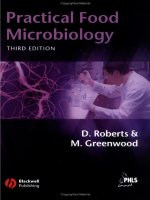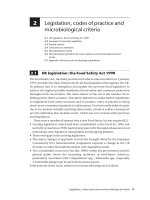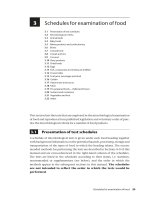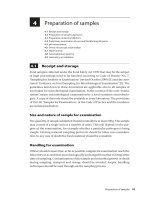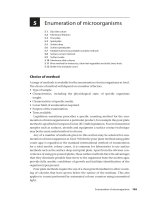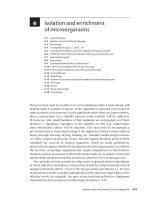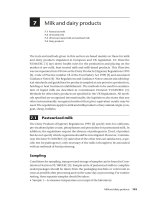Practical Food Microbiology 3rd Edition - Part 10
Bạn đang xem bản rút gọn của tài liệu. Xem và tải ngay bản đầy đủ của tài liệu tại đây (425.18 KB, 48 trang )
Confirmatory biochemical tests
10.1 Acid production from sugars
10.2 CAMP test
10.3 Catalase production
10.4 Coagulase test
10.5 Desoxyribonuclease production
10.6 Gram reaction
10.7 Haemolysis
10.8 Hippurate hydrolysis
10.9 Hydrogen sulphide test
10.10 Indole test
10.11 Motility test
10.12 Nitrate reduction
10.13 O129 sensitivity
10.14 Oxidase test
10.15 Spore stain
10.16 Urease test
10.17 Voges Proskaüer test
The identity of an organism may be confirmed by demonstrating its ability to
perform a number of biochemical reactions, each species conforming to a recog-
nizable result pattern.
Most of the media used in the tests detailed in this section can be obtained
from commercial sources, usually in powder form, and require reconstituting
and sterilizing before use. Some of the reagents prescribed in the tests may not be
available commercially, and so methods for the preparation of these have been
included in this section.
This section does not cover the entire range of biochemical and other identi-
fication tests encountered in food microbiology, but it brings together a number
of those most commonly used and a few which are specific to a particular group
of organisms. Rapid multi-test micro-methods, as discussed briefly at the start of
Section 6, are not included. A fuller range of identification tests can be found in
Cowan and Steel’s Manual for the Identification of Medical Bacteria [1].
Positive and negative controls should be included in each batch of tests. The
reference strains of control organisms are listed in the test methods where
appropriate.
Acid production from sugars
[1]
Examples of sugars include glucose, salicin, mannose, xylose and rhamnose.
10.1
10
Confirmatory biochemical tests 243
CAMP test (for Listeria)
The CAMP (Christie, Atkins, Munch–Petersen) test demonstrates the enhance-
ment of haemolysis of some strains of Listeria spp. by Staphylococcus aureus and
Rhodococcus equi [1–3].
Control organisms
NCTC 11994 Listeria monocytogenes CAMP test (S. aureus) positive
NCTC 11846 Listeria ivanovii CAMP test (S. aureus) negative
NCTC 11846 Listeria ivanovii CAMP test (R. equi) positive
NCTC 11994 Listeria monocytogenes CAMP test (R. equi) negative
10.2
244 Section ten
Reagents
Peptone water (1% peptone, 0.5% NaCl)
10% sugar solutions
Andrade’s indicator solution (or equivalent).
Procedure
(a) Prepare a 10% solution of the required sugar and sterilize at 115°C for 10 min.
Use a small autoclave to avoid prolonged heating which would denature the
carbohydrate. If this is not available, sterilize by filtration.
(b) To 90mL sterile peptone water add 10 mL of the required sterile 10% sugar solu-
tion and 1–2 mL of Andrade’s indicator solution. Alternatively a peptone water
Andrade base may be used.
(c) Transfer 4–5 mL volumes aseptically to sterile bijoux bottles or test tubes. An in-
verted Durham tube may be incorporated to check for gas production. Incubate
overnight at 37°C to check for sterility.
(d) Inoculate a pure culture of the test organism into the bottle or tube of peptone
water sugar and incubate at 37°C (30°C for some organisms, e.g. Yersinia spp.)
for up to 7 days.
(e) Observe the development of a pink coloration which indicates the production of
acid and, if a Durham tube is included, the presence/absence of gas in the
tube.
Control organisms
Control organisms for sugar reactions may vary according to individual labora-
tory preference. Stock cultures should be kept of organisms that have known
positive and negative reactions in each sugar.
Procedure
(a) Prepare two plates by overlaying about 10 mL of nutrient agar with a thin layer
(3–4 mL) of 5% sheep blood agar.
continued
Catalase production
This test detects the production of the enzyme catalase [1], which will split
hydrogen peroxide with the production of gas bubbles. The test can be difficult
to interpret as some species are only weakly reactive. However, as with Listeria, if
adequate controls are included the test is straightforward and an essential part of
the identification procedure.
Control organisms
NCTC 11047 Staphylococcus epidermidis Positive
NCTC 775 Enterococcus faecalis Negative
10.3
Confirmatory biochemical tests 245
(b) Across the centre of one plate streak the recommended standard strain of S. aureus
(NCTC 1803) and across the centre of the other the recommended standard strain
of R. equi (NCTC 1621).
(c) Inoculate the test organism on each plate by streaking at right angles to within
1–2 mm of the standard organisms.
(d) Incubate the plates at 37°C for 18 h.
(e) Examine for enhancement of haemolysis of the test organism by either, both or
neither of the standard strains where the two cultures are closest together. This
appears as a completely clear area shaped like an arrow head. Plate XIV (facing
p. 150) shows both standard strains on a single plate. The slight enhancement of
haemolysis of L. monocytogenes with R. equi is not uncommon but should not be
interpreted as a positive result. Enhancement should be as a clear arrow as shown
for L. ivanovii.
The zones of haemolysis produced vary with different strains of Listeria spp. and inter-
pretation of positive reactions requires practice. Freshly poured plates give the best
results and it is essential to have a control organism on each plate.
To avoid false positive results in this test the following precautions should be taken.
• Glassware has to be clean.
• Blood agar media should not be used.
• Pseudo-catalase reactions may occur in the presence of low concentrations of glucose
(e.g. as in plate count agar). These reactions can be avoided by using media containing
1% glucose.
Procedure
(a) Inoculate the test organisms on a slope of nutrient agar and incubate at 37°C for
24 h.
continued
Coagulase test
Coagulase tests demonstrate the ability of strains of Staphylococcus aureus to pro-
duce substances which will coagulate plasma. With a few exceptions, coagulases
are not produced by other members of the genus Staphylococcus.
Plasma
Allow the plasma to reach room temperature before use.
Types of plasma suitable for method 1 and method 2 include human, rabbit,
horse and pig. Avoid the use of human plasma if possible, but if other types
are not available obtain the human plasma direct from the blood transfusion
service and ensure that it has been tested to screen out human immunodeficien-
cy virus (HIV) and is not hepatitis positive.
Plasma which contains citrate as the sole anticoagulant should not be used as
organisms that can utilize citrate may give a false positive reaction if the test
organism is not a pure culture.
Before routine use check new batches of plasma for their ability to give a
strong reaction.
10.4
246 Section ten
Either
(b) Using a pasteur pipette, gently run 2–3 drops of 3% hydrogen peroxide down the
slope of the medium so that it covers the test growth.
(c) Examine immediately and observe the production of gas bubbles which indicate
a positive reaction. Examine again after 5 min.
Or:
(b) Place a drop of hydrogen peroxide on a glass microscope slide.
(c) With a bacteriological loop, gently rub a colony of the test organism into the
hydrogen peroxide.
(d) Observe for the production of gas bubbles (use a safety cabinet to safeguard
against aerosols).
Alternative method
1 Inoculate a tube of nutrient broth with the test organism and incubate at 37°C
overnight.
2 Add 1 mL of 3% hydrogen peroxide to the culture and examine immediately and
after 5 min for the presence of gas bubbles.
Method 1 Tube test
The tube coagulase test [1,3] detects ‘free’ coagulase, and is stipulated in standard
methods for detection of S. aureus [4].
continued
Desoxyribonuclease production
Strains of Staphylococcus aureus produce a heat-stable desoxyribonuclease
(DNase), or thermonuclease. While other Staphylococcus spp. occasionally pro-
duce DNase, they are not heat stable. The DNA molecule is hydrolysed to a mix-
ture of mono- and polynucleotides by the action of enzymes (DNases) produced
by microorganisms. Agar containing DNA can be used to demonstrate the pro-
duction of microbial DNase [1,5]. Colonies producing DNase are surrounded by
a clear zone when plates are flooded with hydrochloric acid, or a pink zone
against a blue background when flooded with toluidine blue solution [6].
This test may be used in addition to the coagulase test (Section 10.4) for the
confirmation of S. aureus. Alternatively, the method described below is useful as
a screening test but will also detect strains of Staphylococcus that produce heat
10.5
Confirmatory biochemical tests 247
Control organisms
NCTC 6571 Staphylococcus aureus (Oxford strain) Weak positive
NCTC 8532 Staphylococcus aureus Positive
NCTC 11047 Staphylococcus epidermidis Negative
Procedure
(a) Place 0.5 mL of plasma (diluted 1 : 10 in saline) in a 75 mm ¥ 12 mm test tube.
(b) Add 0.1 mL of an 18–24 h nutrient broth culture of the test organism and incubate
at 37°C, preferably in a water bath.
(c) Examine after 1 h, 3 h and 6h incubation for the formation of a clot (see Plate XV,
facing p. 150).
(d) Leave overnight at room temperature and examine again for clot formation.
(e) Record formation of a clot as a positive reaction.
Method 2 Slide test
The slide coagulase test [1] is a rapid test that detects clumping factor (or ‘bound’
coagulase). If negative results are obtained, they should be confirmed by the tube test
(method 1) or desoxyribonuclease (DNase) testing (Section 10.5).
Control organisms
NCTC 6571 Staphylococcus aureus (Oxford strain) Positive
NCTC 11047 Staphylococcus epidermidis Negative
Procedure
(a) Emulsify a colony from a non-selective plate culture of the test organism in two
separate drops of saline on a microscope slide to produce a creamy suspension.
(b) Mix a loopful of undiluted plasma into one of the suspensions and examine for
microscopic clumping occurring within 5–10 s. This indicates the presence of
bound coagulase; delayed clumping does not constitute a positive result.
(c) Examine the second suspension to ensure absence of autoagglutination.
Commercial latex test kits are available that are used in a manner similar to method 2.
labile DNase. Confirmation of DNase positive colonies by coagulase testing is
therefore necessary.
Control organisms
Gram positive organisms:
NCTC 6571 Staphylococcus aureus (Oxford strain) Positive
NCTC 11047 Staphylococcus epidermidis Negative
Gram negative organisms:
NCTC 11935 Serratia marcescens Positive
NCTC 11934 Edwardsiella tarda Negative
248 Section ten
Procedure
(a) Prepare an initial solution of DNA of known concentration in distilled water.
(b) Add sufficient of this solution to nutrient agar immediately before autoclaving to
give a final concentration of 2 mg/mL (DNase agar). Sterilize the medium at 121°C
for 15 min and pour plates as soon as the medium cools to 50°C. Alternatively use
a commercially available complete medium.
(c) Prepare plates containing 15–20 mL of agar.
(d) Place a small spot or a streak of each test colony on the surface of the DNase agar
plate and incubate for 18–24 h at 37°C.
(e) Add 2–3 mL of 1
M
(10%) hydrochloric acid or 0.1% toluidine blue solution to the
plate and rock until the surface is completely covered.
(f) Remove the excess liquid after approximately 30 s.
(g) The medium will become opaque with clear zones around the growth of any
organisms that produce DNase if hydrochloric acid is used. If toluidine blue
solution is used the medium turns blue with the formation of pink zones around
positive strains (see Plate XVI, facing p. 150).
It is advantageous to incorporate dyes into the medium which can distinguish DNA
hydrolysis and thus avoid the use of acid in step (e). Toluidine blue and methyl green
form coloured complexes with polymerized DNA, the colour changes as the DNA is
hydrolysed.
Gram reaction
The Gram reaction is a primary identification procedure used to determine the
ability of a microorganism to retain the first stain used in the procedure when a
decolorizing agent such as ethanol or acetone is added [1,7]. Gram positive
organisms retain the stain but Gram negative organisms are decolorized. The
Gram reaction is a stable characteristic but Gram positivity may be lost as cells
age. A Gram negative reaction may be false either due to the age of the culture or
to excessive decolorization with powerful solvents. Thus a positive result has
10.6
more significance than a negative result. When possible the procedure should be
performed on a young culture (18–24 h old).
Control organisms
NCTC 10447 Staphylococcus epidermidis Positive
NCTC 9001 Escherichia coli Negative
Confirmatory biochemical tests 249
Reagents
Crystal violet (1% aqueous solution)
Lugols iodine (1% iodine, 2% potassium iodide)
Acetone/alcohol mixture: 20% acetone/80% methylated spirit
Safranin solution (0.5% aqueous solution).
Procedure
(a) Using a sterile loop prepare a light suspension of organisms in sterile distilled
water on a clean microscope slide.
(b) Air dry the film and then heat fix by passing the slide twice through a gas flame.
DO NOT OVERHEAT.
(c) Allow to cool.
(d) Place the slide on a staining rack and flood with crystal violet solution.
(e) Leave for 30 s before washing off with running tap water.
(f) Flood the slide with Lugols iodine solution.
(g) Leave for 30s before washing off with running tap water.
(h) To decolorize, run the acetone/alcohol over the film and wash off immediately
with running tap water.
(i) Flood the slide with safranin solution.
(j) Leave for 1 min before washing off with running tap water.
(k) Gently blot the film dry or allow to air dry.
(l) Place a drop of immersion oil on the film and examine under the microscope
using the ¥ 100 oil immersion lens.
(m) Microorganisms that appear dark purple are Gram positive; those that are pink
are Gram negative.
(n) Record the reaction to the Gram procedure and the appearance of the organisms
(shape and any other particular features).
Haemolysis (e.g. for Listeria)
When growing on blood agar media some organisms can produce haemolysins
which diffuse into the medium and affect the red blood cells. This effect may
appear as b-haemolysis, a green zone with the blood cells still intact, or as beta-
haemolysis, a clear colourless zone where the cells are completely lysed [1].
Horse blood cells are most commonly used to demonstrate this effect but
more reliable results may be obtained with sheep blood cells. When recording
results of haemolysis tests the report should state the type (animal species) of
blood cells used.
10.7
Control organisms
NCTC 11994 Listeria monocytogenes Positive
NCTC 11288 Listeria innocua Negative
250 Section ten
Procedure
(a) Inoculate a blood agar plate with the test organism using a loop in the normal
manner ensuring that the organism is spread sufficiently to produce single
colonies. Incubate overnight (18–24 h) at 37°C.
(b) Examine the plate for visible zones of haemolysis around the colonies. Trans-
mitted light improves contrast.
Hippurate hydrolysis (for campylobacters)
Campylobacter jejuni can hydrolyse hippurate to form glycine and benzoic acid
[1,8,9]. The production of glycine can be detected by the addition of a ninhydrin
solution to the test medium.
Control organisms
NCTC 11322 Campylobacter jejeuni Positive
NCTC 11366 Campylobacter coli Negative
10.8
Reagents
Ninhydrin: 3.5% solution in equal parts acetone and butanol. Store in the dark at room
temperature.
Sodium hippurate: 5% aqueous solution. Distribute in 0.5 mL volumes and store at
-20°C.
Procedure
(a) Grow the test organism on blood agar for 18–24 h at 37°C in a microaerobic
atmosphere.
(b) Transfer a 2 mm loopful of the colonial growth from this plate to 2 mL of distilled
water. Mix the organisms to suspend and add 0.5 mL of sodium hippurate
solution.
(c) Incubate in a water bath at 37°C for 2 h.
(d) Add 1 mL of ninhydrin solution and leave for 2h at room temperature (or 10 min
at 37°C).
(e) A positive reaction is shown by the development of a purple colour which indi-
cates the formation of glycine (see Plate XVII, facing p. 150).
Hydrogen sulphide test (for salmonellae,
campylobacters and yersiniae)
The production of hydrogen sulphide is a feature of the normal metabolic action
of many microorganisms. Triple sugar iron (TSI) agar slopes are used in the iden-
tification of enteric pathogens. This medium turns black if the test organism
produces hydrogen sulphide [1].
In general, many Salmonella spp. are hydrogen sulphide positive, while
Yersinia spp. are negative. In Campylobacter spp. hydrogen sulphide production
is variable between and within species.
Control organisms
NCTC 11934 Edwardsiella tarda Positive
NCTC 12145 Campylobacter jejuni Positive
NCTC 7475 Proteus rettgeri Negative
NCTC 11168 Campylobacer jejuni Negative
10.9
Confirmatory biochemical tests 251
Procedure
(a) Prepare tubes of TSI agar as slopes with a generous butt.
(b) Using a straight wire inoculate the test organism deep into the butt of the medium
and streak up the slope.
(c) Incubate for 18–24 h at 37°C for salmonellae and 30°C for yersiniae. For campy-
lobacters, incubate in a reduced oxygen, increased carbon dioxide atmosphere for
up to 3 days.
(d) Examine for blackening of the medium (see Plate XVIII, facing p. 150).
Rapid test for Campylobacter
(a) Suspend a large loopful (5 mm) of growth from an 18–24 h blood agar culture,
incubated at 37°C in not more than 7% oxygen, in the upper third of 3–4 mL of
ferric bisulphite pyruvate (FBP) medium in a small screw-capped tube.
(b) Incubate closed at 37°C for 2 h.
(c) Examine for blackening of the medium.
Indole test
The ability of certain microorganisms to break down the amino-acid trypto-
phan, with the production of indole, is an important characteristic used in the
classification and identification of bacteria. The presence of indole in the
growth medium can be detected by the addition of an indole reagent (e.g.
Kovac’s); a pink coloration is produced in the reagent [1].
10.10
Control organisms
NCTC 9001 Escherichia coli Positive
NCTC 11935 Serratia marcescens Negative
252 Section ten
Reagent
Kovac’s reagent: dissolve 5 g of p-dimethyl aminobenzaldehyde in 75 mL of analytical
grade amyl alcohol. The reagent will dissolve more rapidly if warmed gently in a water
bath at 55°C. Cool and add 25 mL of concentrated hydrochloric acid. Mix gently and
store at 4°C.
Procedure
(a) Inoculate a tube of peptone water, tryptone water or broth containing 0.03%
tryptophan with a pure culture of the test organism and incubate at 37°C for up to
48 h. Some tests may require incubation at 30°C or 44°C.
(b) Add 5–10 drops (0.2 mL) of Kovac’s reagent, shake and allow to stand for up to
10 min. A pink coloration at the surface indicates the presence of indole.
Motility test (for listerias and other
organisms)
[1]
Control organisms
NCTC 11994 Listeria monocytogenes Positive at 21°C
NCTC 11934 Edwardsiella tarda Positive at 37°C
NCTC 8574 Shigella sonnei Negative
or:
NCTC 9528 Klebsiella aerogenes Negative
10.11
Procedure
(a) Prepare small tubes of nutrient broth.
(b) Inoculate with the test organism and incubate at the appropriate temperature.
For Listeria spp. this should be 21°C for 4–6 h.
(c) Place a drop of the broth on the surface of a glass microscope slide and cover with
a glass cover slip.
(d) Examine by optical microscopy for motility of the test organism. Listeria spp.
exhibit a typical ‘tumbling’ motility at 21°C but not at 37°C.
A ‘hanging drop’ preparation may help microscopic examination. Place a drop of the
test culture on a glass cover slip and invert over a thin ring of Vaseline
“
or Plasticine
“
on a glass microscope slide
Nitrate reduction
Nitrate reduction may be shown by detection of one of the breakdown products
or by demonstration of the disappearance of nitrate from the medium. The
products of reduction range from nitrite to gaseous nitrogen. The objective of
the first test is to show the presence of nitrite; if this is not detected the medium
is then tested for the presence of residual nitrate. If no residual nitrate can be de-
tected it indicates that the nitrite has been further broken down. For organisms
that do not appear to reduce nitrate, a reducing agent (zinc dust) is then added.
If a red colour develops this signifies that the nitrate has not been reduced. If no
red colour is produced then there is no nitrate present and the nitrite has been
further reduced [1].
Control organisms
NCTC 7464 Bacillus cereus Positive
NCTC 9001 Escherichia coli Negative
10.12
Confirmatory biochemical tests 253
Reagents
Nitrate broth or nitrate motility medium.
Nitrite reagents: A. 5-amino-2-naphthalene-sulphonic acid (0.1% solution in 15% by
volume acetic acid). B. Sulfanilic acid (0.4% solution in 15% by volume acetic acid).
Zinc dust.
Procedure
(a) Inoculate tubes of nitrate broth or nitrate motility medium (stab inoculation)
with the test strain and incubate for up to 5 days at 30°C.
(b) Mix equal volumes of nitrite reagents A and B just before use.
(c) To each tube of nitrate broth or nitrate motility medium showing growth add
0.2–0.5 mL of the reagent mixture.
(d) Formation of a red colour confirms the reduction of nitrate to nitrite.
(e) If there is no red colour after 15 min add a small amount of zinc dust and allow to
stand for 15 min.
(f) If a red colour develops after the addition of zinc dust then no reduction of nitrate
has taken place.
(g) If there is no red colour there is no nitrate present, the nitrite has been further
reduced.
O129 sensitivity
The pteridine derivative O129 (2,4-diamino-6,7-di-isopropyl pteridine phos-
phate) specifically inhibits the growth of Vibrio spp., although the number of
strains showing resistance seems to be increasing. Resistance can be demon-
strated by placing discs of the reagent on plates previously seeded with the
10.13
organisms and incubating. A zone of inhibition indicates sensitivity to the
reagents [1,10].
Control organisms
NCTC 10885 Vibrio parahaemolyticus Positive (sensitive)
NCTC 10662 Pseudomonas aeruginosa Negative (resistant)
254 Section ten
Reagents
O129 discs: 10 µg and 150 µg
Blood agar plates
Sterile saline (0.85% sodium chloride).
Procedure
(a) Prepare a light suspension of the test organism in saline.
(b) Inoculate the surface of a blood agar plate with this suspension.
(c) Using sterile forceps place discs containing 10 µg and 150 µg of O129 reagent on
the plate.
(d) Incubate the plates at 37°C for 18–24 h.
(e) Examine for inhibition of growth of the test organism around the discs.
(f) Record as sensitive (S) or resistant (R).
(g) Include control strains with each set of tests. The following results should be
obtained:
V. parahaemolyticus: 10 µg R 150 µg S
Ps. aeruginosa: 10 µg R 150 µg R
Oxidase test
The test to detect the production of cytochrome c oxidase by microorganisms is
used to categorize them into groups at an early stage of their identification [1].
Control organisms
NCTC 10662 Pseudomonas aeruginosa Positive
NCTC 9001 Escherichia coli Negative
10.14
Reagent
Oxidase reagent [1]:
Either:
(a) Freshly prepared each day: dissolve 0.1 g of tetramethyl p-phenylene diamine
dihydrochloride in 10 mL of distilled water. Addition of 1% ascorbic acid and
storage in the dark extends the life of the reagent to 4 to 5 days. Discard if a purple
coloration develops.
Or:
continued
Spore stain
The ability to form spores is a characteristic used to confirm the identity of some
species of bacteria. The combination of spore morphology and biochemical tests
has long been used for the identification of Bacillus spp. These organisms can be
divided into groups on the basis of the shape, size and location of the spores
within the vegetative cells. These can be determined either by the use of phase
contrast microscopy or with a spore stain. A simple procedure that does not
involve heating is described [12].
Control organisms
NCTC 7464 Bacillus cereus Positive
NCTC 9001 Escherichia coli Negative
10.15
Confirmatory biochemical tests 255
(b) Prepared from stable basal solution [11]:
Ethylene diamine tetraacetic acid (EDTA) disodium salt 1 g
Sodium thiosulphate pentahydrate 0.5 g
Distilled water 100 mL
Dilute 10 mL of basal solution to 100 mL with distilled water. Add 0.2 g of tetra-
methyl p-phenylene diamine dihydrochloride.
Procedure
(a) Moisten a piece of filter paper in a Petri dish with two or three drops of oxidase
reagent.
(b) Using a wooden stick, glass rod or platinum loop (do not use a nichrome bacteri-
ological loop), transfer a colony of the test organism to the filter paper and rub it
on the area moistened with oxidase reagent.
(c) Observe for the development of a dark purple coloration indicating the produc-
tion of oxidase.
Prepared in this way, the basal solution is stable for 6 months and the reagent for 2–4
weeks at 4°C. Discard if a purple coloration develops.
Reagents
10% aqueous malachite green solution
0.5% aqueous safranin solution.
Procedure
(a) Prepare a film of the test organism on a clean microscope slide.
continued
Urease test
Urease activity is shown by the production of ammonia from a solution of urea.
The change in pH can be demonstrated by the addition of an indicator to the
medium [1].
Control organisms
NCTC 7475 Proteus rettgeri Positive
NCTC 11935 Serratia marcescens Negative
10.16
256 Section ten
(b) Flood the slide with aqueous malachite green solution and leave to stand for
40–45 min.
(c) Wash under running tap water.
(d) Flood the slide with 0.5% aqueous safranin solution.
(e) Leave for 15 s and rinse under running tap water.
(f) Gently blot the film dry or allow to air dry.
(g) Bacterial bodies stain red, spores green.
(h) Record the position and shape of the spores and whether they distend the bact-
erial cell.
Procedure
(a) Prepare tubes of Christensen’s urea medium. These may be as agar slopes or
broths.
(b) Inoculate a slope or broth with the test organism and incubate at 30°C or 37°C.
The test can often be read after 5–6 h incubation in a water bath.
(c) Observe for a pink coloration of the medium which denotes the production
of urease.
Voges Proskaüer test (for listeriae and other
organisms)
[1]
Control organisms
NCTC 11994 Listeria monocytogenes Positive
or:
NCTC 11935 Serratia marcescens Positive
NCTC 9001 Escherichia coli Negative
or:
NCTC 7475 Proteus rettgeri Negative
10.17
References
1 Barrow GI, Feltham RKA, eds. Cowan and Steel’s Manual for the Identification of Medical
Bacteria, 3rd edn. Cambridge: Cambridge University Press, 1993.
2 BS EN ISO 11290-1 (BS 5763 Part 18). Microbiology of Food and Animal Feeding Stuffs
—
Horizontal Method for the Detection and Enumeration of Listeria monocytogenes. Part 1.
Detection Method. Geneva: International Organization for Standardization (ISO),
1997.
3 McLauchlin J. The identification of Listeria species. DMRQC Newsletter 1988; 3: 1–3.
(Internal publication of the Public Health Laboratory Service (PHLS).)
4 BS EN ISO 6888-1. Microbiology of Food and Animal Feeding Stuffs
—
Horizontal Method
for the Enumeration of Coagulase-positive Staphylococci. Technique Using Baird–Parker
Agar Medium. Geneva: International Organization for Standardization (ISO), 1999.
5 Jeffries CD, Holtman DF, Guse DG. Rapid method for determining the activity of
microorganisms on nucleic acids. J Bacteriol 1957; 73: 590–1.
6 Streitfeld MM, Hoffmann EM, Janklow HM. Evaluation of extracellular deoxyribonu-
clease activity in Pseudomonas. J Bacteriol 1962; 84: 77–80.
7 ISO 7218 (BS 5763 Part 0). Microbiology of Food and Animal Feeding Stuffs
—
General Rules
for Microbiological Examinations. Geneva: International Organization for Standardiza-
tion (ISO), 1996.
8 Hwang MN, Ederer GM. Rapid hippurate hydrolysis method for presumptive identi-
fication of group B streptococci. J Clin Microbiol 1975; 1: 114–15.
9 Skirrow MB, Benjamin J. Differentation of enteropathogenic campylobacter. J Clin
Path 1980; 33: 1122.
10 Furniss AL, Lee JV, Donovan TJ. The Vibrios.Public Health Laboratory Service Monograph
Series No. 11. London: HMSO, 1997.
11 Daubner I, Mayer J. Die anwendung des oxydase-testes bie der hygienisch-bakteriolo-
gischen wasseranalyse. Arch Hyg Bakt 1968; 152: 302–5.
12 Holbrook R, Anderson JM. An improved selective and diagnostic medium for the
enumeration of Bacillus cereus in foods. Can J Microbiol 1980; 26: 753–9.
10.18
Confirmatory biochemical tests 257
Reagents
5% a-naphthol solution in ethanol (the colour of the reagent should not be darker
than straw colour)
40% potassium hydroxide solution.
Procedure
(a) Prepare tubes containing 5 mL of glucose phosphate broth.
(b) Inoculate with a pure culture of the test organism and incubate at 37°C for 48 h.
(c) Add 0.6 mL of a-naphthol solution and 0.2 mL of potassium hydroxide solution.
(d) Shake vigorously and observe for the development of a pink/red coloration.
(e) Slope the tubes and leave at room temperature for 1 h. Examine again for pink/red
coloration before declaring the test negative.
Appendix A 259
Appendix A: Quick reference guide
to the microbiological tests
1
2
3
4
5
6
7
8
9
10
11
12
13
14
15
16
17
18
19
20
21
22
23
24
25
26
27
28
29
30
Colony count (aerobic)
Other specified count (e.g. pre-incubated)
Aeromonas spp.
B. cereus and Bacillus spp.
Brucella spp.
Campylobacter spp.
Clostridia
Coliforms (30°C)
Coliforms
Enterobacteriaceae
Enterococci
Escherichia coli
Lactobacilli and other lactic acid bacteria
Listeria monocytogenes
Pseudomonas spp.
Salmonella spp.
Shigella spp.
Staphylococcus aureus
Vibrio spp.
Yeasts and moulds
Yersinia spp.
Peroxidase
Phosphatase
Alpha-amylase
A
W
pH
Can examination
Cryptosporidium
Direct microscopic smear
Shelf-life
Animal feeds
Baby foods
Bakery products, confectionary
Brine—bacon curing
Canned food
Cereals and rice
Coconut
Dairy products
Dried foods
– cheese
– cream (untreated)
– cream (pasteurized)
– cream (UHT)
– ice-cream
– ice-cream (UHT mix)
– milk (liquid)
– milk-based drinks
– milk (dried)
– yoghurt
– untreated
– pasteurized
– sterilized
– UHT
– pasteurized
– sterilized or UHT
Appendix A
Quick reference guide to
the microbiological tests
Key
The tests marked with this symbol are, in the terminology
defined in Section 3 of this manual, 'statutory' tests
The tests marked with this symbol are 'recommended' tests
The tests marked with this symbol are 'supplementary' tests
Eggs
Fish and other seafood
Frozen lollies
Fruit juice, beverages and slush drinks
Gelatin
Mayonnaise and sauces
Meat
Pre-cooked foods
Surfaces and containers
Vegetables and fruit
Water
– shell
– raw bulk liquid
– pasteurized bulk liquid
– albumen, liquid
– albumen, crystalline
– powdered
– preserved by other methods
– raw fish
– cooked fish
– crustaceans (raw)
– crustaceans (cooked)
– molluscs (raw)
– molluscs (cooked)
– preserved
– fruit juice
– carbonated soft drinks
– slush drinks
– red, sausage, poultry (raw)
– cooked
– cooked meat pies
– cured meats
– processed non-cured meats
– ready-to-eat foods
– cook–chill, cook–freeze
– hands
– food surfaces and equipment
– cloths
– containers
– fresh
– blanched and frozen
– potable, including that used in food production
– natural mineral water
– bottled spring/drinking water
1
2
3
4
5
6
7
8
9
10
11
12
13
14
15
16
17
18
19
20
21
22
23
24
25
26
27
28
29
30
* * * **
* For pH > 4.5. For products containing ice-cream or milk.
*
*
Appendix B: Investigation and
microbiological examination of
samples from suspected food
poisoning incidents
Introduction
Whenever a food poisoning incident is suspected every effort should be made to
obtain accurate histories of food consumption from the individuals who have
developed symptoms. Remnants of uneaten food associated with the incident
should be taken from both the place of preparation and that of consumption. At
the earliest opportunity as much detail as possible should be collected
concerning the method of preparation, the cooking and the storage of all
implicated food items, as memories are short. Even small delays in obtaining
this information can hamper an epidemiological investigation.
Food-borne infections vary in their mode of action on the gastrointestinal
tract. Those in which the infecting organism has multiplied to a large extent in
the foodstuff before ingestion will have a shorter incubation period than those
in which growth within the intestine has to occur before symptoms are ex-
perienced. Pre-formed toxin, in food, is likely to act on the stomach and cause
rapid onset vomiting. The toxins of Clostridium botulinum are absorbed and
produce more serious sequelae by affecting the central nervous system. The
longest incubation times are associated with those organisms that subsequently
invade the blood stream after entering the lower intestine. Intermediate delay
periods of onset occur where the mode of action is by way of enterotoxins
liberated only when the organisms begin to either lyse or sporulate.
Knowledge of the clinical details of the illness and the presentation of
symptoms provide vital clues as to the likely food poisoning organism (Tables
B.1 (infections) and B.2 (intoxications)).
It is rarely practicable or necessary to culture for all pathogens in all samples.
Relevant tests will be selected in the light of available clinical and
epidemiological information. For example a pathogen may already have been
isolated from human specimens examined in parallel with the food. The residue
of samples should be stored under refrigeration for possible further
examination.
Figure B.1 illustrates a scheme to be considered when a suspect food arrives in
the laboratory. Much of the work may be omitted or postponed if the clinical
information gives a clear lead or if the pathogen has already been isolated from
the patient. Detailed methods for the isolation and identification of the various
Appendix B 263



